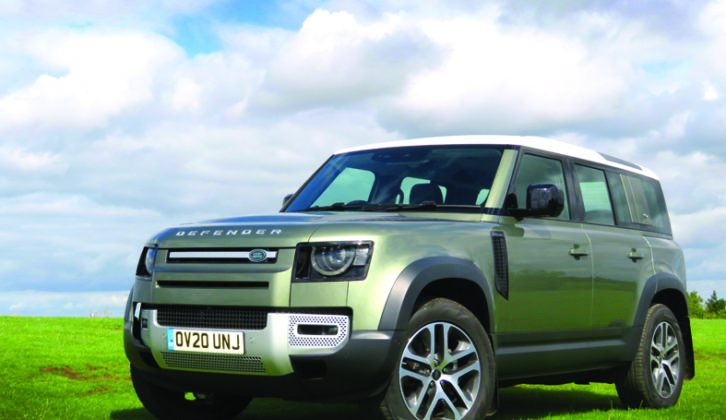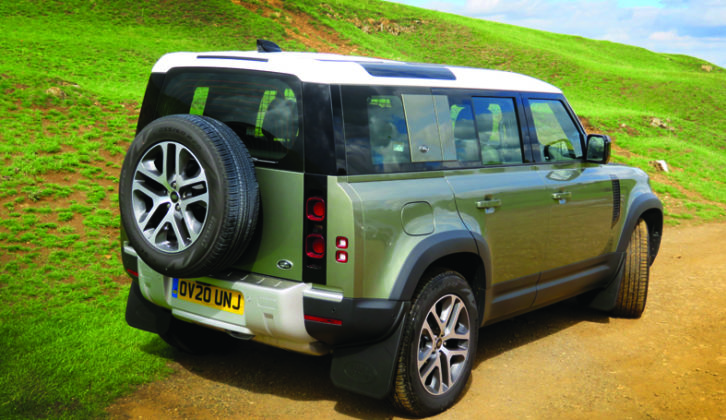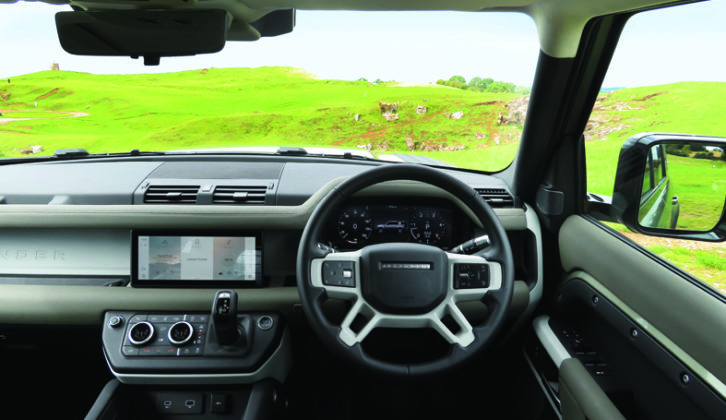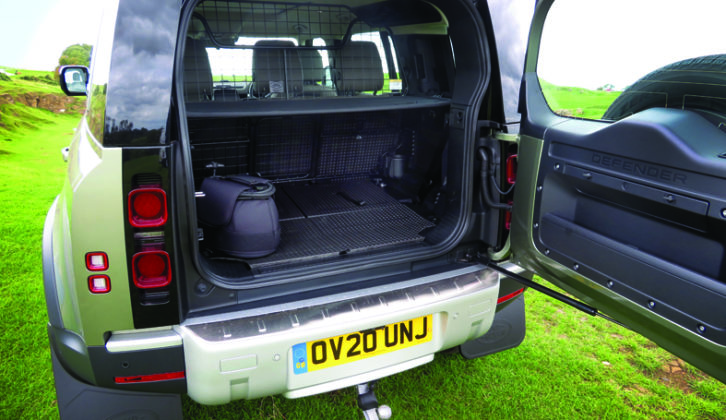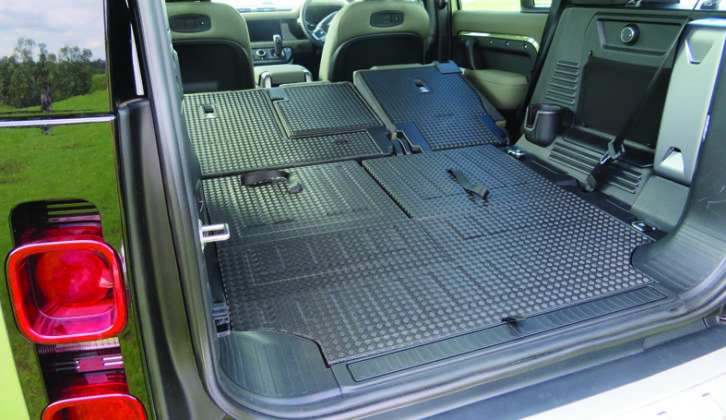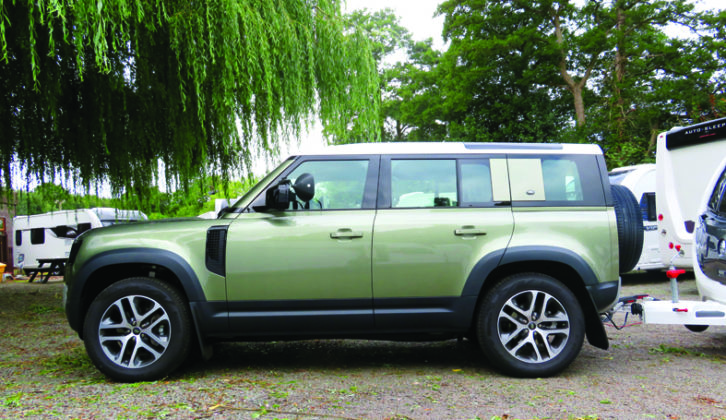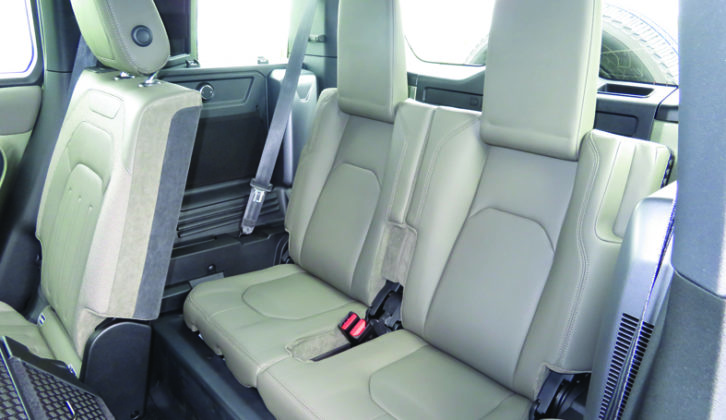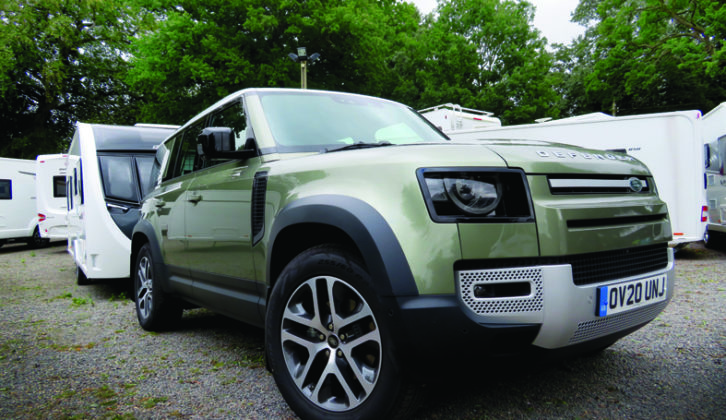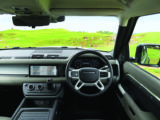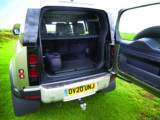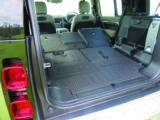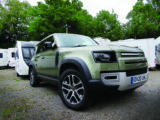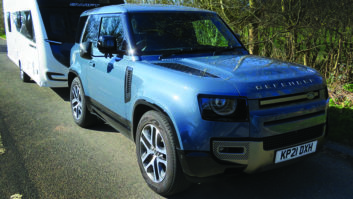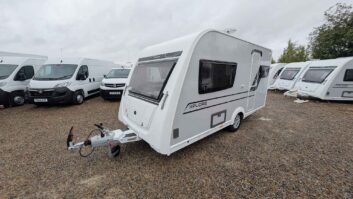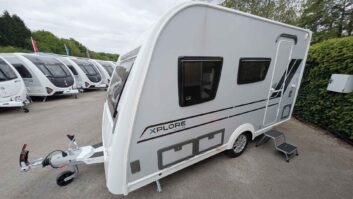The long-awaited Land Rover Defender revives a famous name. Under the skin, it’s related to the Discovery, but developed for even greater off-road ability.
Buyers have a choice of diesel, petrol and mild-hybrid engines. A plug-in hybrid model is on the way. Land Rover expects the D240 diesel to be the most popular version, and that’s the model we have on test.
What are we looking for?
It’s not easy to replace an icon. We want to know if the new Land Rover is a worthy successor to the original Defender. Just as importantly, does the Defender have what it takes to compete with other big 4x4s as a tow car, and can it justify its high price?
Towing ability
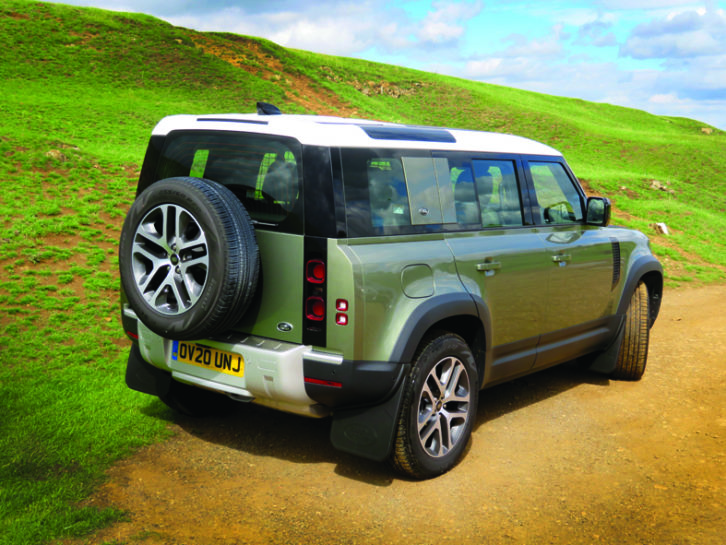
Being heavy isn’t necessarily a guarantee of towing ability, but it’s a pretty good start. With a kerb weight of 2380kg, the Defender is certainly heavy. With an 85% match figure of 2023kg, a nose weight limit of 150kg, and a legal maximum of 3500kg, just about any caravan makes a sensible match.
High kerb weights are a feature of every model in the range, not just the D240 110 diesel. Even the three-door petrol model has a kerbweight of 2140kg.
With post-lockdown caravan sales booming, the choice of tourers for us to borrow was rather limited. The Swift Fairway 880 was the heaviest available, with a MiRO of 1536kg.
While the caravan towed for our test was lighter than we would have liked, the tail end of Storm Francis made up for this, with blustery winds.
The Defender coped admirably with such difficult conditions. Every now and again, we could feel the caravan tugging gently at the back of the car, especially on exposed sections of motorway or when overtaking an HGV. But the movements were always slight and the Defender stayed on course.
Perhaps a Mercedes G-Class would be even more secure in windy weather, but there’s not a lot in it.
On country roads, the car continued to impress. Fairly soft long-travel suspension makes for a comfortable ride on bumpy surfaces, but there’s enough control to remain composed at speed.
Getting up to speed takes a little longer than it might in some £50,000 SUVs. With 240hp and 317lb ft of torque, the Defender has less pulling power than a Volkswagen Touareg or a Volvo XC90 diesel. Don’t get us wrong, the Defender’s engine is up to the job – but it doesn’t have the punchy response of its brawnier rivals.
You notice this most on hilly roads, as the automatic gearbox has to shift down a couple of ratios to maintain speed. The Land Rover will hold its pace, but you’re aware that the engine is working quite hard at times.
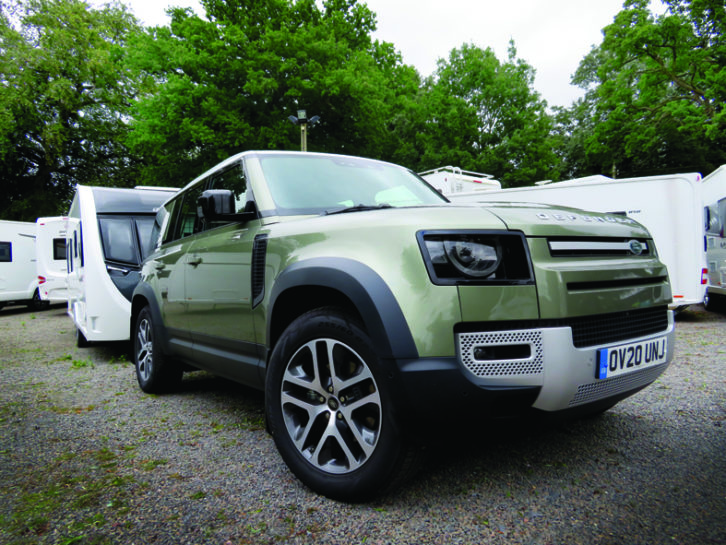
Hill starts are very straightforward. The electronic parking brake holds car and van without fuss and releases smoothly. There’s enough pull to move away promptly on a 1-in-10 slope, although the engine does sound a little strained as the revs rise.
Low-speed manoeuvres are easy, with a smooth throttle response and a 360-degree camera system to help you see what you are doing. The rear-facing camera gives a clear view of the tow ball to help with hitching.
The towbar itself deploys electronically at the touch of a button inside the tailgate. It’s part of the Towing Pack, which costs an eye-watering £2000, but includes Advanced Tow Assist, which will steer for you when reversing onto a pitch.
A full-size spare wheel is standard, and sits on the tailgate so that you can get to it without needing to remove luggage from the boot. However, it sticks out far enough to get in the way of the Al-Ko stabiliser lever when hitching up. It’s a bit of an irritation, and means that hitching or unhitching is easier with the tailgate open.
A couple of niggles aside, the Defender is an extremely able tow car. Some SUVs at this price have greater performance in reserve, but few can provide more comfort or remain more stable.
Solo driving
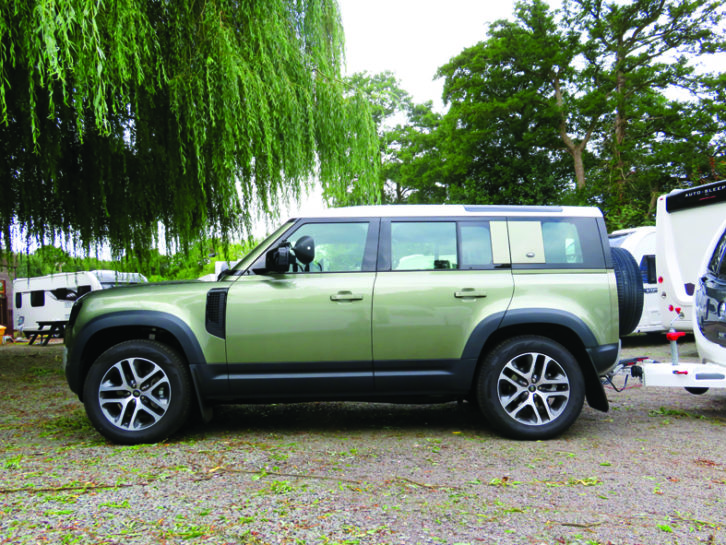
The original Defender was an old-school off-roader; the ability to leave the beaten track far behind was more important than driving on the road. The new version is a much more rounded vehicle, equally at home on the road or off it.
The latest generation of Land Rover’s Terrain Response system adjusts the car’s engine, gearbox and other systems to suit the type of ground being covered. As you would expect, the Defender has full-time four-wheel drive, and a twin-speed transfer ‘box to allow the driver to select lower ratios for serious off-roading.
Air suspension also plays its part in the Defender’s off-road ability, allowing the driver to increase the ride height further if required. This gives the Defender 110 an exceptional wading depth of 900mm. That’s 200mm more than the Mercedes G-Class, one of the few cars that can really rival the Defender’s capabilities in the rough.
On Tarmac, the Land Rover rides very comfortably. The air suspension, standard on the 110, smothers bumpy surfaces.
It’s been quite a while since we’ve driven its stablemate, the Discovery, but we think that the Defender is even more comfortable. It’s very quiet at speed, with only a little wind noise to disturb the peace.
The Defender doesn’t handle with the agility of an Audi Q7 or a BMW X5, but it corners neatly, so long as you don’t get too enthusiastic, and the steering is accurate and well weighted.
As when towing, the engine’s relatively modest power and torque are noticeable in solo driving. It’s certainly not a slow car, but there’s no shortage of much quicker SUVs for similar money. It would help if the gearbox were a little faster to change down, something that can be sorted out by changing to ‘sport’ mode or using the manual override function.
Space and practicality
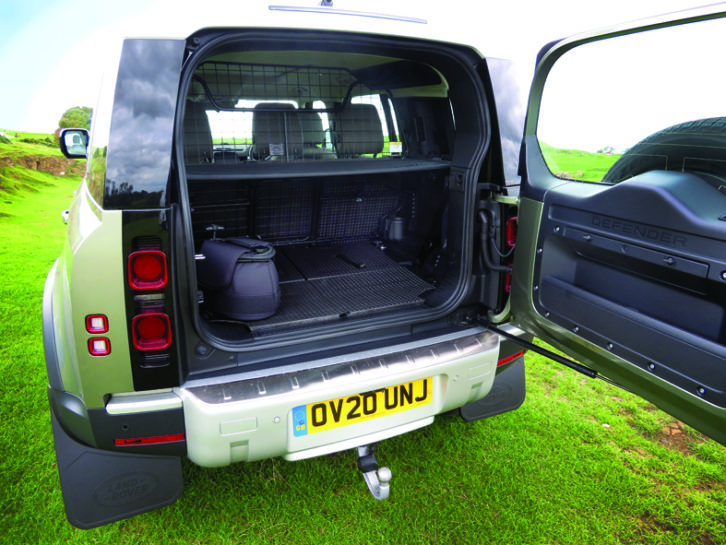
The cabin design combines durability with a luxury finish and high-tech infotainment.
The wipe-clean floor and exposed Torx head bolts give the interior a back-to-basics feel that contrasts with the 10-inch touchscreen and digital display in place of conventional dials. The mix of styles might sound contradictory, but to our eyes, it works brilliantly.
The driver sits up high, looking down on other traffic from an armchair-like seat with 12-way electronic adjustment. Drivers of all shapes and sizes should find a sound, supportive driving position.
There’s lots of useful storage space in the front of the cabin, including large door bins and deep tray at the bottom of the centre console.
The second row of seats is almost as comfy as the front, with ample head- and legroom for adults. There’s only a slight hump to the transmission tunnel, a definite plus if you’re travelling with three in the back.
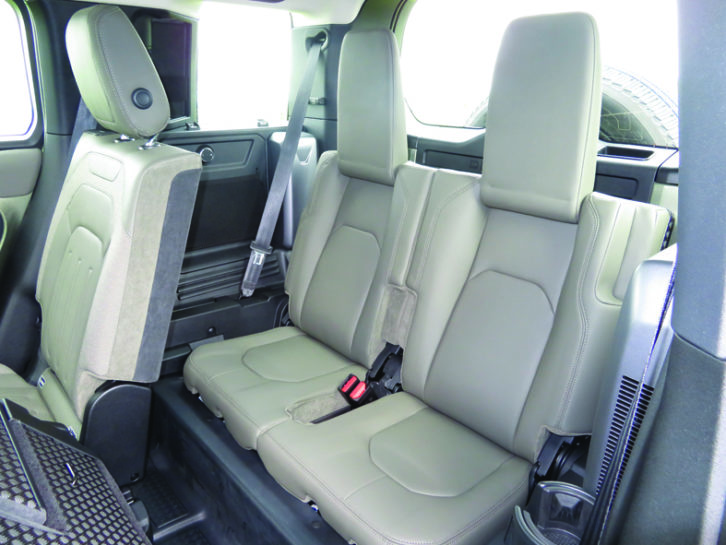
As standard, the Defender is a five-seater. Our test car was equipped with the optional third row of seats, a £1020 option. Legroom is poor in seats six and seven – Land Rover does describe the car as a 5+2 rather than a true seven-seater.
There’s little luggage space if the third row is upright, but a useful 743 litres with the third row in the floor. That rubber floor should prove hardwearing and easy to clean. However, the side-hinged tailgate can be an inconvenience if you are loading or unloading in a tight space.
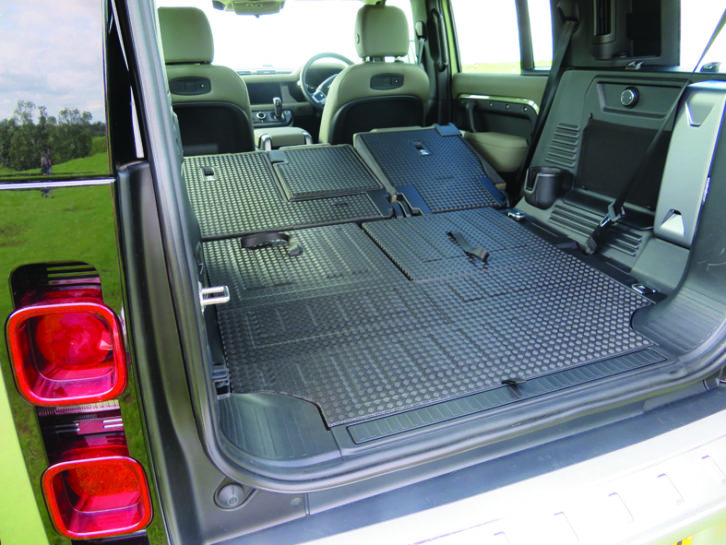
Buying and owning
Prices start from £40,330 for the three-door 90. Our five-door 110 D240 SE has a list price of £56,040, rising to £66,908 with all of the options. That means the Defender’s pricing overlaps with the larger Discovery’s.
Fuel bills will be high. We saw just 32.1mpg on a solo motorway drive, dropping to 23mpg while towing. High emissions make the vehicle costly on tax for company car drivers.
To some extent, the price is offset by exceptionally strong resale values. After three years and 36,000 miles, What Car? predicts the Defender will be wroth 64% of its original price.
How much will it cost on finance?
The Land Rover Defender is an expensive vehicle to finance. The D240 SE will cost £779.80 per month over three years with a Land Rover Personal Contract Purchase (PCP) agreement. That’s based on payment of an initial £5604 deposit and an annual mileage of no more than 10,000. Excess mileage will be charged at 14p per mile. The optional final payment is £30,122.
What can I tow with a B licence?
If you passed your test on or after 1 January 1997 and haven’t taken a towing test since, you have a B licence. This allows you to tow cars and caravans with a combined Maximum Authorised Mass (MAM) of 3500kg. The Defender’s Gross Vehicle Weight/MAM of 3215kg leaves just 285kg for the van. B licence holders will need to take a towing test to upgrade to a B+E licence to tow with a Defender.
Verdict
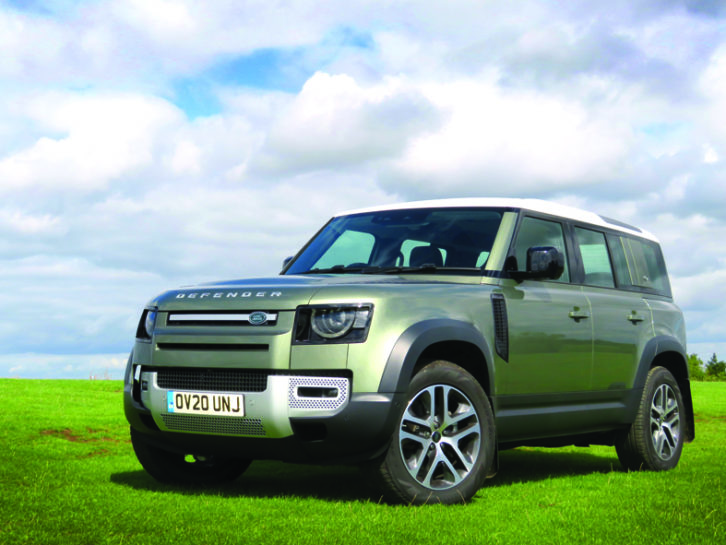
Land Rover faced a tough challenge in replacing the old Defender. In most respects, it has succeeded brilliantly.
Off-road ability is matched to a fine drive on Tarmac, sublimely comfortable and quiet at speed. If you want to drive from one end of the country to the other and finish your trip feeling fresh, this is the car for the job.
It tows very well, too. The Land Rover shrugged off high winds and kept the caravan firmly under control. The diesel engine copes easily with towing duties, although some rivals will pull a big caravan up to speed more quickly. New six-cylinder diesels are coming for the 2021 model year, and promise extra punch.
If you want seven seats, the Discovery is a better choice than the Defender – the latter’s optional third row seems a bit of an afterthought. Otherwise, we can see the Defender attracting buyers who might have chosen another Land Rover; to our eyes, the Defender’s rugged design has a lot more presence and character than the Discovery’s.
Does the Defender justify its high price? It’s certainly pricey compared with the utilitarian original. But when you consider a Mercedes G-Class costs over £96,000, perhaps Land Rover isn’t being too greedy.
We’re more concerned by the Defender’s running costs than its list price. Fuel economy is poor.
It’s not perfect, but the Defender is a hard vehicle to resist. There are very few cars which can perform off Tarmac and on it as well as the new Land Rover.
Or you could try…
If you’ve enjoyed reading this article, why not get the latest news, reviews and features delivered direct to your door or inbox every month. Take advantage of our brilliant Practical Caravan magazine SUBSCRIBERS’ OFFER and SIGN UP TO OUR NEWSLETTER for regular weekly updates on all things caravan related.
Hill starts are very straightforward. The electronic parking brake holds car and van without fuss and releases smoothly
Technical Specifications
| Engine Size | 1999 cc |
| Kerbweight | 2380 kg |
| 85% KW | 2023 kg |
| Towball Limit | 150 kg |
| Maximum Towing Limit | 3500 kg |
| Power | 240 bhp |
| Torque | 317 lb ft |
| Offical MPG | 29.3 mpg |
| Towing MPG | 23 mpg |
| CO₂ | 234 g/km |
